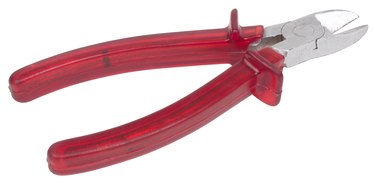Things You'll Need
Electrician screwdrivers
White nail polish
Diagonal pliers/wire cutters
Wire strippers
Lineman’s pliers/Electrician’s pliers
AWG 12, White, solid copper wire
Yellow wire nuts
Two 20-Amp, 120-Volt, SPCBs (Single Pole Circuit Breakers)
20-Amp, 120-Volt, grounding receptacle
Black, plastic electrical tape
Receptacle cover plate

Converting a 220-volt branch circuit into a 110-volt branch circuit is a relatively easy project for the moderately-skilled do-it-yourselfer. Most 220V branch circuits use a 2 or 3-conductor cable with a bare grounding wire. Article 200.7(C)(1) of the NEC (National Electric Code), Publication 70 of the NFPA(National Fire Protection Association) allows a White-insulated, Neutral conductor to be used as a current carrying conductor as long as it's permanently re-identified at each point where it's visible and accessible using a color other than white, gray, or green.
If the 220-volt circuit was wired using a re-identified white conductor as a hot conductor
Step 1
Turn off the 220-volt CB controlling the circuit and remove the breaker panel/service panel cover and trim.
Video of the Day
Step 2
Disconnect the two wires from the 2P (Pole) CB and remove the CB from the panel. Depending on the type of panel that you have, the CB may simply snap out or you may have to remove a screw securing it to the Buss Bar. Use caution here because parts of the panel Buss Bars will be hot even if you turn the main service disconnect here. Use insulated Electrician's screwdrivers to remove these screws and be careful to not slip off the screw and short the Buss Bar out against the panel back or to short the Buss Bars out one to the other. Either will cause a large surge of current and can atomize a screwdriver and subject the holder to fatal electric shock.
Step 3
Install the two-20A CBs on the Buss Bars where you removed the 220-Volt, 2P CB. One of the new breakers will become a spare breaker for future use. Connect the Black conductor to one of the breakers. The electrician installing the 220-Volt branch circuit will have painted the white conductor red so you will have to re-identify it as a neutral conductor by painting it white. Some people like using standard latex paint, but nail polish is a good choice because it dries in seconds.
Step 4
Cut a length of white wire long enough to reach down to the neutral bar and strip ¾-inches of insulation from each end. Secure one end to the neutral bar and route it up to where you have re-identified the old neutral conductor. Holding the end together, side-by-side, twist the bare ends together in a clockwise direction using the Linemen's Pliers/Electrician's Pliers. Finish this splice by screwing a wire nut securely over the splice
Replace the service panel inner trim and outer cover.
Step 5
Remove the 220 receptacle and re-identify the neutral conductor here as you did at the service panel. Wire the 110-Volt receptacle as you normally would, black wire to the brass screw, white wire to the silver screwand the bare or green grounding wire to the green screw.
Step 6
Secure the receptacle in the device box and install the cover plate.
Turn the CB on.
Converting a circuit wired with 3-wire cable plus ground
Step 1
Turn off the circuit breaker and remove the receptacle cover. Remove the screws holding the receptacle to the box and pull the receptacle out of the box. There should be four conductors entering the box from the same cable, a red one, a black one, a white one, and a bare or green one. There are two ways to convert this 220-Volt branch circuit into a 110-Volt branch circuit.
The first method requires removing the double-pole breaker and replacing it with two single-pole breakers as you did in steps one and two above. This time you will connect the Black conductor to one of the breakers but cap off the Red conductor and fold it neatly along the side of the service panel. The Red wire won't be used.
The second method is to convert the circuit by wiring the branch circuit as a multiwired branch circuit per Article 210.4 of the NEC. With this conversion, you will leave the double pole breaker in place because the Code requires that the disconnecting means disconnect both hot legs of a multiwired branch circuit simultaneously.
With either of these conversion scenarios the branch circuit neutral is already connected to the service panel neutral bar.
Step 2
The first method requires you to cap off the Red wire off in the device box and push it to the rear of the device box and connect the 110-Volt receptacle as you did in step five above.
Step 3
The second method requires you to isolate the two halves of the duplex receptacle by removing the tab that connects the two brass colored terminals together. Leave the tab on the silver colored terminals in place because the multiwired circuit will have a common neutral.
Step 4
Connect the black conductor to one brass colored screw and the red conductor to the other brass colored screw. Connect the white, neutral conductor to one of the silver colored screws. Connect the bare or green-colored conductor to the green grounding screw.
Step 5
Secure the receptacle in the device box, install the cover plate and turn the CB on.
Warning
The Multiwired branch circuit supports 110-Volt line to neutral load, so, in essence it’s two separate 110-volt branch circuits with a common neutral. The potential danger inherent in this circuit is an open neutral conductor between the receptacle and the service panel. Without a continuous neutral the 110-Volt receptacle circuit reverts back to a 220-Volt receptacle if there’s an appliance plugged into both halves of the duplex receptacle. This condition can cause serious damage to one or both of the connected appliances because the appliance is connected in series with 220-Volts applied across them.
Video of the Day